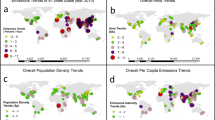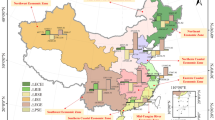Abstract
China pledges to peak CO2 emissions by 2030 or sooner under the Paris Agreement to limit global warming to 2 °C or less by the end of the century. By examining CO2 emissions from 50 Chinese cities over the period 2000–2016, we found a close relationship between per capita emissions and per capita gross domestic product (GDP) for individual cities, following the environmental Kuznets curve, despite diverse trajectories for CO2 emissions across the cities. Results show that carbon emissions peak for most cities at a per capita GDP (in 2011 purchasing power parity) of around US$21,000 (80% confidence interval: US$19,000 to 22,000). Applying a Monte Carlo approach to simulate the peak of per capita emissions using a Kuznets function based on China’s historical emissions, we project that emissions for China should peak at 13–16 GtCO2 yr−1 between 2021 and 2025, approximately 5–10 yr ahead of the current Paris target of 2030. We show that the challenges faced by individual types of Chinese cities in realizing low-carbon development differ significantly depending on economic structure, urban form and geographical location.
This is a preview of subscription content, access via your institution
Access options
Access Nature and 54 other Nature Portfolio journals
Get Nature+, our best-value online-access subscription
$29.99 / 30 days
cancel any time
Subscribe to this journal
Receive 12 digital issues and online access to articles
$119.00 per year
only $9.92 per issue
Buy this article
- Purchase on Springer Link
- Instant access to full article PDF
Prices may be subject to local taxes which are calculated during checkout



Similar content being viewed by others
Data availability
Details on the methodology and data for estimating CO2 emissions of 50 Chinese cities are summarized in the Supplementary Information, and any other datasets generated during this study are available upon request from the corresponding authors.
References
Watts, M. Cities spearhead climate action. Nat. Clim. Change 7, 537–538 (2017).
IPCC Climate Change 2014: Mitigation of Climate Change (eds Edenhofer, O. et al.) (Cambridge Univ. Press, 2014).
United Nations Department of Economic and Social Affairs World Urbanization Prospects: The 2014 Revision: Highlights (United Nations, 2014).
Rosenzweig, C., Solecki, W., Hammer, S. A. & Mehrotra, S. Cities lead the way in climate-change action. Nature 467, 909–911 (2010).
Duren, R. M. & Miller, C. E. Measuring the carbon emissions of megacities. Nat. Clim. Change 2, 560–562 (2012).
Weiss, K. Cities bask in spotlight at Paris climate talks. Nature https://doi.org/10.1038/nature.2015.19006 (2015).
Wang, H., Zhang, Y., Lu, X., Nielsen, C. P. & Bi, J. Understanding China’s carbon dioxide emissions from both production and consumption perspectives. Renew. Sustain. Energy Rev. 52, 189–200 (2015).
National Bureau of Statistics of the People’s Republic of China China Statistical Yearbook 2012 (China Statistics Press, 2013).
Qi, Y., Wu, T., He, J. & King, D. A. China’s carbon conundrum. Nat. Geosci. 6, 507–509 (2013).
Wiedenhofer, D. et al. Unequal household carbon footprints in China. Nat. Clim. Change 7, 75–80 (2017).
Baeumler, A. et al. Sustainable Low-carbon City Development in China (World Bank, 2012).
Kennedy, C. et al. Greenhouse gas emissions from global cities. Environ. Sci. Technol. 43, 7297–7302 (2009).
Liu, Z. et al. Features, trajectories and driving forces for energy-related GHG emissions from Chinese mega cites: the case of Beijing, Tianjin, Shanghai and Chongqing. Energy 37, 245–254 (2012).
Kennedy, C. A., Ibrahim, N. & Hoornweg, D. Low-carbon infrastructure strategies for cities. Nat. Clim. Change 4, 343–346 (2014).
Zhang, Y. et al. A dual strategy for controlling energy consumption and air pollution in China’s metropolis of Beijing. Energy 81, 294–303 (2015).
Dhakal, S. Urban energy use and carbon emissions from cities in China and policy implications. Energy Policy 37, 4208–4219 (2009).
Bi, J. et al. The benchmarks of carbon emissions and policy implications for China’s cities: case of Nanjing. Energy Policy 39, 4785–4794 (2011).
Wang, H. et al. Mitigating greenhouse gas emissions from China’s cities: case study of Suzhou. Energy Policy 68, 482–489 (2014).
Wang, H., Zhang, R., Liu, M. & Bi, J. The carbon emissions of Chinese cities. Atmos. Chem. Phys. 12, 7985–8007 (2012).
Ramaswami, A. et al. Urban cross-sector actions for carbon mitigation with local health co-benefits in china. Nat. Clim. Change 7, 736–742 (2017).
Cai, B., Guo, H., Cao, L., Guan, D. & Bai, H. Local strategies for China’s carbon mitigation: an investigation of Chinese city-level CO2 emissions. J. Clean. Prod. 178, 890–902 (2018).
Shan, Y. et al. City-level climate change mitigation in China. Sci. Adv. 4, eaaq0390 (2018).
Gurney, K. R. et al. Track urban emissions on a human scale. Nature 525, 179–181 (2015).
Dodman, D. Blaming cities for climate change? An analysis of urban greenhouse gas emissions inventories. Environ. Urban 21, 185–201 (2009).
Hillman, T. & Ramaswami, A. Greenhouse gas emission footprints and energy use benchmarks for eight U.S. cities. Environ. Sci. Technol. 44, 1902–1910 (2010).
Sovacool, B. K. & Brown, M. A. Twelve metropolitan carbon footprints: a preliminary comparative global assessment. Energy Policy 38, 4856–4869 (2010).
Boden, T. A., Marland, G. & Andres, R. J. Global, Regional, and National Fossil-Fuel CO 2 Emissions (Oak Ridge National Laboratory, US Department of Energy, 2017); http://cdiac.ornl.gov/CO2_Emission/timeseries/national
Liu, Z. et al. A low-carbon road map for china. Nature 500, 143–145 (2013).
Feng, K. et al. Outsourcing CO2 within china. Proc. Natl Acad. Sci. USA 110, 11654–11659 (2013).
Chen, Y., Ebenstein, A., Greenstone, M. & Li, H. Evidence on the impact of sustained exposure to air pollution on life expectancy from China’s Huai River policy. Proc. Natl Acad. Sci. USA 110, 12936–12941 (2013).
Shen, H. et al. Urbanization-induced population migration has reduced ambient PM2.5 concentrations in China. Sci. Adv. 3, e1700300 (2017).
Huo, H., Zhang, Q., Liu, F. & He, K. Climate and environmental effects of electric vehicles versus compressed natural gas vehicles in China: a life-cycle analysis at provincial level. Environ. Sci. Technol. 47, 1711–1718 (2013).
Güneralp, B. et al. Global scenarios of urban density and its impacts on building energy use through 2050. Proc. Natl Acad. Sci. USA 114, 8945–8950 (2017).
Ürge-Vorsatz, D. et al. Locking in positive climate responses in cities. Nat. Clim. Change 8, 174–177 (2018).
Mi, Z. et al. Chinese CO2 emission flows have reversed since the global financial crisis. Nat. Commun. 8, 1712 (2017).
Guan, D. et al. Structural decline in China’s CO2 emissions through transitions in industry and energy systems. Nat. Geosci. 11, 551–555 (2018).
McGranahan, G. & Satterthwaite, D. Urban centers: an assessment of sustainability. Annu. Rev. Environ. Resour. 28, 243–274 (2003).
Creutzig, F., Baiocchi, G., Bierkandt, R., Pichler, P. P. & Seto, K. C. Global typology of urban energy use and potentials for an urbanization mitigation wedge. Proc. Natl Acad. Sci. USA 112, 6283–6288 (2015).
Lu, X. et al. Challenges faced by China compared with the US in developing wind power. Nat. Energy 1, 16061 (2016).
International Council of Local Environmental Initiatives Local Government Operations Protocol for the Quantification and Reporting of Greenhouse Gas Emissions Inventories (ICLEI, 2010); https://s3.amazonaws.com/icleiusaresources/lgo_protocol_v1_1_2010-05-03.pdf
Grossman, G. M. & Krueger, A. B. Economic growth and the environment. Q. J. Econ. 110, 353–377 (1995).
Shahbaz, M. & Sinha, A. Environmental Kuznets curve for CO2 emissions: a literature survey. J. Econ. Stud. 46, 106–168 (2019).
Li, T., Yong, W. & Zhao, D. Environmental Kuznets curve in China: new evidence from dynamic panel analysis. Energy Policy 91, 138–147 (2016).
Acknowledgements
This study was supported by the National Key R&D Program of China (2016YFA0600204), National Natural Science Foundation of China (NNSFC) (41371528, 71433007, 71690244), IGSNRR and Youth Innovation Promotion Association CAS (2019055) and the Harvard Global Institute of Harvard University.
Author information
Authors and Affiliations
Contributions
H.W. conceived and led the research. H.W., X.L. and J.B. designed the paper. Y.S., Y.D. and H.W. calculated emissions. Y.L., G.Z. and M.B. performed emission trends analysis. H.W., X.L., Y.D. and C.P.N. interpreted the data. H.W., X.L., C.P.N. and M.B.M. drew conclusions and wrote the paper with input from all co-authors.
Corresponding authors
Ethics declarations
Competing interests
The authors declare no competing interests.
Additional information
Publisher’s note: Springer Nature remains neutral with regard to jurisdictional claims in published maps and institutional affiliations.
Supplementary information
Supplementary Information
Supplementary Tables 1–8, Figs. 1–9, methods and references.
Rights and permissions
About this article
Cite this article
Wang, H., Lu, X., Deng, Y. et al. China’s CO2 peak before 2030 implied from characteristics and growth of cities. Nat Sustain 2, 748–754 (2019). https://doi.org/10.1038/s41893-019-0339-6
Received:
Accepted:
Published:
Issue Date:
DOI: https://doi.org/10.1038/s41893-019-0339-6
This article is cited by
-
Urbanization and Benefit of Integration Circular Economy into Waste Management in Indonesia: A Review
Circular Economy and Sustainability (2024)
-
Predictability of fossil fuel CO2 from air quality emissions
Nature Communications (2023)
-
Spatial correlation network structure characteristics of carbon emission efficiency and its influencing factors at city level in China
Environment, Development and Sustainability (2023)
-
Breaking down nationally determined contribution (NDC) targets into subnational actions: a two-staged allocation approach study in China
Environment, Development and Sustainability (2023)
-
The effect of the carbon tax on the low-carbon level under different market powers
Environment, Development and Sustainability (2023)



